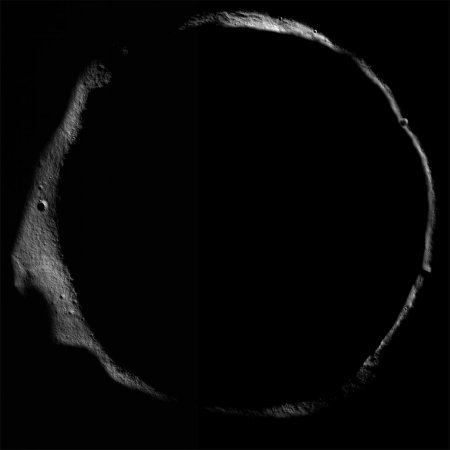
The Lunar Reconnaissance Orbiter imaged the edges of one of the moon’s darkest places this week, the 10 kilometre wide Erlanger crater near its north pole.
Because the moon only tilts back and forth by 1.5 degrees the sun never shines on the floor of the deeper craters near each pole.
However NASA is already working with India to decipher readings recently made by both that country’s Chandrayaan lunar orbiter and its own LRO in a tandem fly over in which the Indian probe bathed the darkness with radar signals that were received on the American probe.
That data may identify any features that could include ice.
Sometime between 7-10 October this year, another US probe, LCROSS or the Lunar Crater Observation and Sensing Satellite, is due to direct a large impactor into a 9000 kmh collision with the similarly permanently shaded floor of a crater near the south pole.
A major observational program by the lunar satellites and space and ground based telescopes will then be part of efforts to analyse the impact plume and measure the ratio of dust to ices, including any signature consistent with water ice.
If such sources of water and thus hydrogen and oxygen exist in significant quantities at the lunar poles they could radically improve the design of vehicles able to carry large payloads further into the solar system, possibly including manned missions to Mars.
Mercury may also have deeply shaded craters near its polar regions, however most planetary scientists doubt they could retain volatile ices.
However they will also be imaged by the Messenger satellite, which will finally attain orbit around the innermost planet on 18 March 2011 if all goes to plan.
Messenger makes its third close bypass of Mercury on 29 September in the last of a series of gravitational ‘assists’ that included a fly by of Earth and two of Venus in order to bring its velocity into line with that needed for its intended Mercurian orbit.








Crikey is committed to hosting lively discussions. Help us keep the conversation useful, interesting and welcoming. We aim to publish comments quickly in the interest of promoting robust conversation, but we’re a small team and we deploy filters to protect against legal risk. Occasionally your comment may be held up while we review, but we’re working as fast as we can to keep the conversation rolling.
The Crikey comment section is members-only content. Please subscribe to leave a comment.
The Crikey comment section is members-only content. Please login to leave a comment.